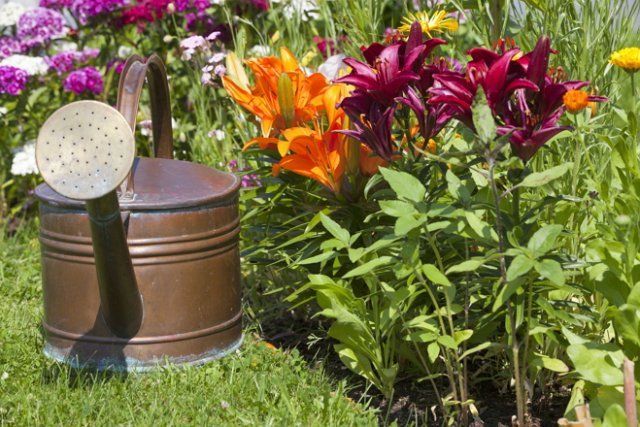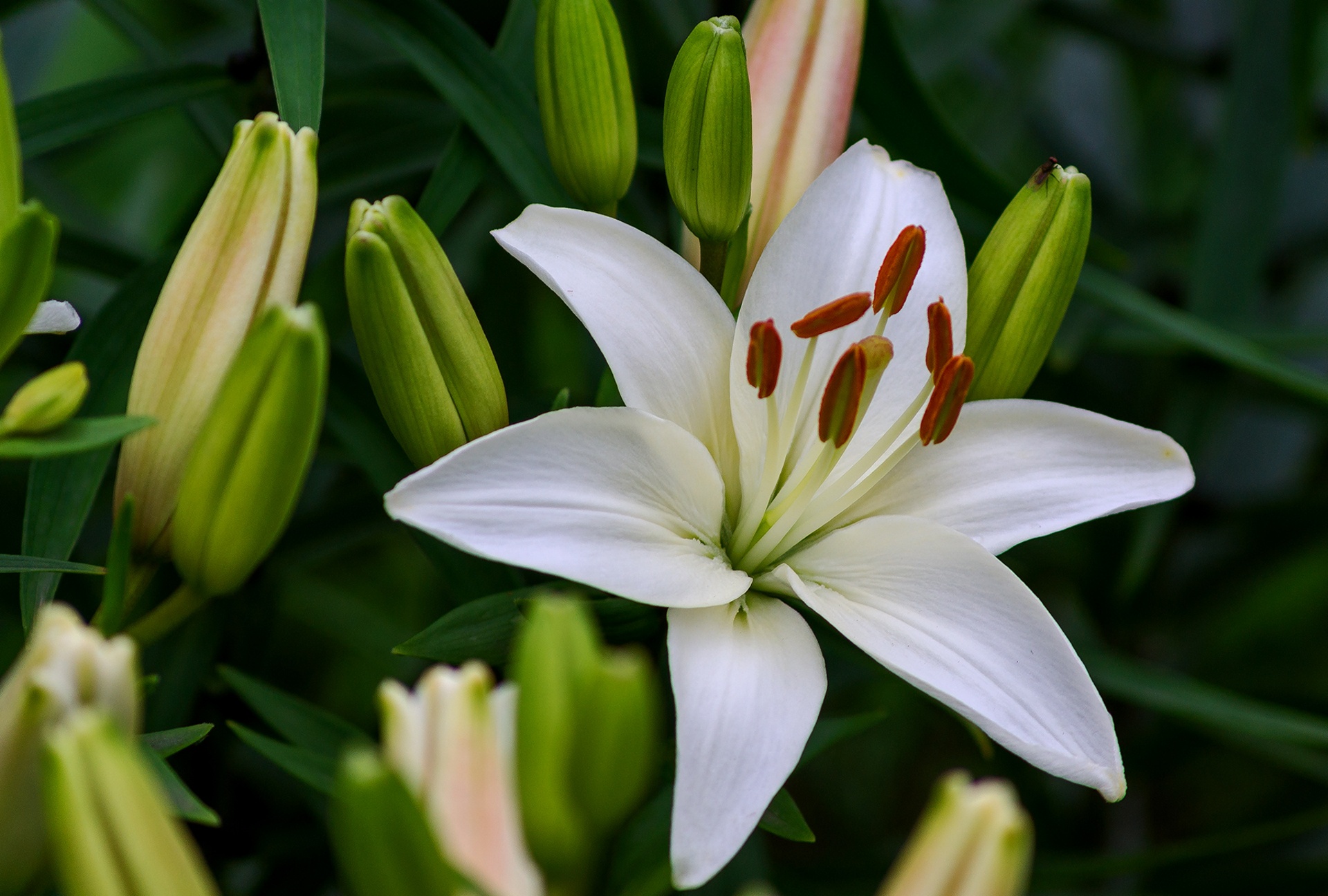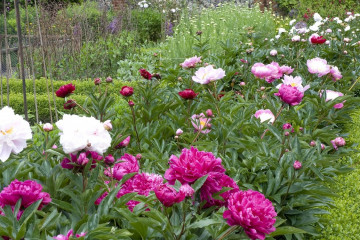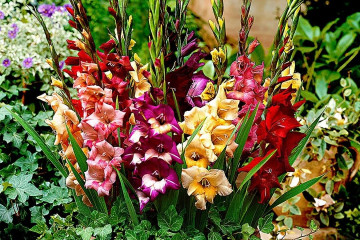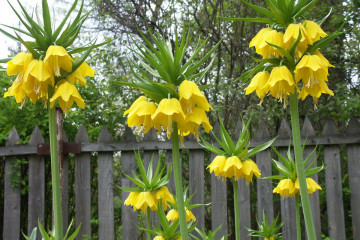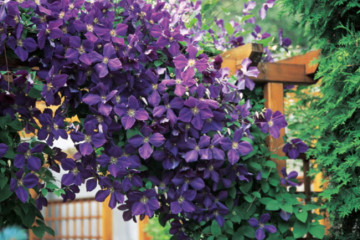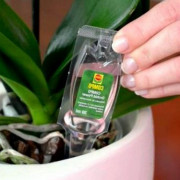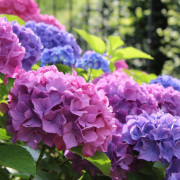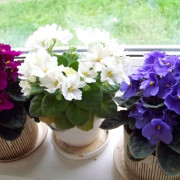How to feed lilies in autumn and spring before flowering
Content:
Lilies are a wonderful decoration for the garden. With them, you can create flower beds, arrange bouquets. These flowers need proper care for their full development. It is important for gardeners to know how to feed lilies at different times of the year and at different stages of their development.
How to feed lilies
Flowers are fed with inorganic fertilizers. The first feeding is done in early May after the emergence of the bulbs. Plants need nitrogen to grow well. Complex fertilizers are applied in liquid form. The next two dressings are carried out in the middle and at the end of the month.
Feeding lilies throughout the year - recommendations for beginners
Before flowering, lilies need potassium magnesium. She will make the flowers in the garden more vibrant and lush. Liquid feeding is carried out after watering the plants.
House lilies also like additional feeding, which is introduced from the period of stem formation.
Application technology and composition
Feeding lilies requires some knowledge. The appearance of the plants will depend on whether the fertilizers were applied correctly.
Fertilizers are applied very carefully so as not to damage the bulbs. The soil is loosened from above. Digging is carried out to a depth of 35-40 cm.
As a top dressing they use:
- organic fertilizers;
- nitrogen fertilizers;
- ash.
From organic fertilizers used mullein, diluted with water 1 to 10. The most popular nitrogen fertilizer is ammonium nitrate. One tablespoon of the product is sprayed onto 1 sq. meter. Ash improves soil composition and repels pests.
Spring feeding for lush bloom
Plants will be more robust if nitrogenous fertilizers are applied before flowering in spring. The soil temperature must be 6 ° C or higher, otherwise the fertilizing will not be absorbed by the plants. Use urea or ammonium nitrate. 2 tablespoons of dry granules are consumed per 1 square meter. If the beds are tilted, it is better to use liquid top dressing, as the nutrients will be washed out during watering or rain. 10 liters of fertilizer are consumed per 1 square meter.
When buds appear, plants need phosphorus. Foliar dressing is carried out.
Summer feeding
In summer, plants also need to be fertilized, but with a lower concentration of nutrients. Top dressing is carried out in July with fertilizers diluted in water. For this purpose, superphosphate or potassium magnesium is suitable. Fertilizers are diluted in slightly warmed water. The liquid strengthens the stem, promotes bright flowering of plants.
It is better to use ash from organic matter. It is sprayed onto the flower bed on the ground so as not to touch the leaves. Plants should be watered.
Autumn feeding
In autumn, the plants fade, but they also need fertilization to restore and strengthen the bulbs. Potassium and phosphorus are added during this period.Fertilizers will protect plants from fungus and other diseases. Watering of plants is reduced. Fertilizing with mineral fertilizers is also reduced, since they can provoke growth.
Organic fertilizers will help plants survive the long winter:
- humus;
- compost;
- rotted manure.
Why fertilizing lilies is important
The bulb is the underground part of the plant. Full growth, the formation of lily buds will depend on its development. It is important to know what and how to fertilize lilies. Timely and high-quality feeding will help you get healthy green mass and beautiful flowering next year.
What can not be fed lilies
Lilies should not be fed with fresh manure. Plants can become sick with fungus and wither away.
The best time to fertilize
Lilies are fertilized depending on the climatic zone. You should focus on the temperature of the soil. The first top dressing is carried out when the soil warms up to + 6-7 ° C. It could be early April—May. Top dressing is also carried out, focusing on the height of the stem, it should be at least 10 cm.
How to fertilize lilies
Experienced gardeners know when to plant lilies in their garden beds. This is best done during the off-season. In the spring, transplanting lily bulbs into open ground is done as early as possible. In autumn, the most suitable months are September and October. Bulbs with a dying stem, that is, those that have completed the growing season, should be planted.
Fertilizing lilies when planting
It is important to know how to plant lilies correctly. They do not like shady places and constantly moist, compacted soils. They should not be planted under spreading trees in the shade. Depending on the variety, they choose sunny places or partial shade.
Plants grow and develop well if there is a sufficient amount of humus in the root area. For each square meter of planting, a bucket of well-rotted compost is brought in and dug up. You can add urea in the amount of 200 g per 10 sq. meters. So that the plants bloom well for digging, 500 g of potassium sulfate 1 kg of superphosphate is scattered. An alternative can be complex fertilizers: diammofosk or azofosk.
Feeding lilies before flowering
During the appearance of the first buds, lilies need mineral fertilizers with potassium and phosphorus. It is convenient to use complex formulations that are sold in specialized stores.
Fertilization features at the budding stage
At the budding stage when applying fertilizers, you should mulch the soil well with sawdust or cut grass. These measures are necessary to avoid drying out the topsoil with strong evaporation. Abundant infrequent watering is required.
How to feed lilies in June during flowering
Gardeners should know how to feed lilies in June before flowering. The rich color of the petals will help give ammophosk. It also helps plants to resist stress, disease and pests.
Feeding flowering lilies is carried out in the same way as during budding.
Usually urea or nitrophosphate is used. Plants are watered at the root, water should not fall on the leaves.
Top dressing after cutting or flowering
In the autumn, plants are preparing for winter and proper feeding is especially important for them. At the end of summer, new fertilizers are applied. These can be complex preparations containing superphosphate and potassium sulfate. They will replenish the supply of nutrients and protect against disease.Nitrogen fertilizers cannot be applied.
You should focus on the climatic conditions of the lily growing zone. Mineral fertilizers should not be applied too late, otherwise green shoots may appear. You can use mature compost or manure-based humus. The soil will be replenished with useful substances and will receive additional shelter from frost. The compost layer is located on top and is about 10 cm. In the spring it is stirred by loosening.
Lily transplant after flowering
After 3-5 years, the lilies must be transplanted to another place, otherwise the flowering will no longer be of high quality. The bulbs release toxic substances that are detrimental to the plant itself. In addition, the mother bulb overgrows, which causes the flower to shrink.
It is best to replant plants in the fall. After flowering, the bulbs take root better in a new place, and there is no need to store them.
So for the Moscow region, the most suitable will be the end of August and the beginning of September. In more southern regions, lilies are planted in September-October.
Soil selection
The correct choice of soil for transplanting lilies is an important condition for their successful growth. Depending on the variety of plants, it is determined what kind of soil they need: acidic or alkaline.
Top dressing when transplanting
When planting lilies, double superphosphate and potassium sulfate are added to the soil. Lime or dolomite flour is added to acidic soil.
When to plant lilies outdoors
Thus, lilies are suitable plants for the garden. They are undemanding to temperature extremes, relatively resistant to diseases and pests.
Since the full growth of plants depends on the condition of the bulb, they must be fertilized. When planting, at the stage of budding and flowering, different feeding is required. You need to pay attention to the season and the climatic zone. Top dressing is also important when transplanting plants to a new place. It is a prerequisite for the full growth and development of lilies.
The result of flowering will also depend on the quality of plant care throughout the year.

